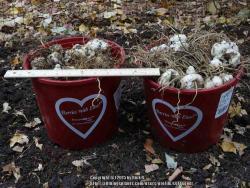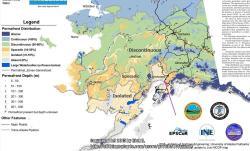Lorn, are you seeing that Anchorage, Alaska is USDA zone 5? There are lots of differences due to latitude and geography, but temperature minimums are much like yours, yes?
While I wholeheartedly agree with all your premises, my conclusions are different. I think the soil temps in zone 5 Anchorage are probably like mine in zone 4 Minnesota.
We were both writing at the same time, Lorn, so these are my thoughts:
This past fall I harvested several dozen mature asiatic lily bulbs from a few hybridizing efforts. I deemed them rejects and they were destined for culinary consumption. When I dug them, all the soil was shaken off and piled into open plastic pots (with holes on the bottom).

After a week, I tucked some cellophane wrap over the tops, to prevent over-dehydration. Cellophane wrap (Glad Wrap, for instance) still allows for some gas and water vapor exchange, but prevents most of it. I let them sit in the garage here in zone 4 through the winter. I kept a thermometer nearby, as the question of minimum temperature survivability had me wondering. Well, I chickened out after four days with minimum temps of 15, 12, 12 and 14°F. Temperatures were below zero outside, and kept descending in the ensuing days, so I left the bulbs in the garage, but put them inside styrofoam coolers. The temp inside the cooler never went below 11°F. Bulbs never actually froze. Since then, they have thawed(above 32°F), and I even had brought a couple inside the house after the "big freeze test" and let them be overnight so I could examine them. Bulbs were nice and firm without any visible damage. If there was any damage to how growth continues into the spring, I can't say.
What does this mean? Maybe a lot, maybe not much. First realize these tested bulbs were asiatic hybrids, not orientals, trumpets, species or other kinds. Even within the asiatic group, there are lots of differences, and it's likely these differences will be reflected in cold tolerance, too. Realistically, I would guess this means that asiatic hybrids can survive soil temps of 18-20°F. Actually it may be even lower, since I didn't test to lower temps. Regarding low temperature tolerance of plants in pots, I've done a lot of impromptu investigation over the years with alpine and lower elevation plants of many genera. I have been pleasantly surprised at their tenacity for life. Remember though, that these lily bulbs were slowly acclimatized to the cold temps, and ever so slightly dehydrated. Also critical, is that these lilies were at rest, not actively growing. The ones sprouting in your garage now, Mary, would easily be damaged at 30 or 32°F.
But next year you will be able to sink your pots in the ground outside, best on their side as Lorn does, put mulch over them after the ground freezes, and leave them that way until early spring. Or you could do as Lorn says, with pots in the garage. I did say your garage was too warm, but I should have said that that is a complicating factor. Following Lorn's advice for in the garage is sound in my opinion, too.
-- -- -- -- -- -- -- -- -- -- -- -- -- -- --
Incidentally, with my unofficial experiment, I had a few smaller lily bulbs that had initially dried like all the rest, but I put them inside a
sealed ziplock freezer bag, with all other conditions being the same. They are still nice and firm, but have begun to mold.





